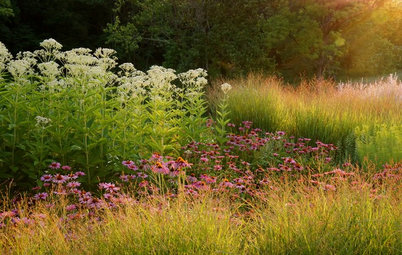Gardening Guides
You Don't Need Prairie to Help Pollinators
Woodlands, marshes, deserts — pollinators are everywhere
A current thought in landscape design seems to be that if you want to help pollinators, you’ve got to have meadow or prairie filled with wildflowers. Of course, the majority of the U.S. is not or never was prairie — but does that mean you can’t help pollinators? Not by a long shot. Heck, there are over 4,000 native bee species, and they can’t all live in a prairie filled with goldenrod and asters. Here are four ways to support the life cycles of pollinators in various ecosystems around the country.
2. Grasses and sedges. Insects lay eggs on countless grass and sedge (Carex spp.) species. There are grasses and sedges native to prairies and meadows, but there are also many species native to a variety of other ecosystems. For example, you’ll see many sedge species while walking in a woodland or near marshes.
More and more, gardeners and designers are beginning to see the aesthetic and ecological benefits of grasses and sedges, which can double as living mulch, reducing maintenance, outcompeting weeds and shading the soil.
See more guides to growing grasses and sedges in your yard
Shown: Clustered field sedge (Carex praegracilis, zones 6 to 10) in a Los Angeles front yard
More and more, gardeners and designers are beginning to see the aesthetic and ecological benefits of grasses and sedges, which can double as living mulch, reducing maintenance, outcompeting weeds and shading the soil.
See more guides to growing grasses and sedges in your yard
Shown: Clustered field sedge (Carex praegracilis, zones 6 to 10) in a Los Angeles front yard
3. Arid-region plants. Flowering desert native plants like cactus, agave (Agave spp.), yucca (Yucca spp.) and wild heliotrope (Phacelia distans, zones 7 to 10) are crucial for adult insects, and of course those insects end up on the menu for birds, lizards and countless other wildlife. Feeding a small songbird chick in the nest can require hundreds of insects each day.
Discover more plants native to the desert Southwest
Discover more plants native to the desert Southwest
4. A mixture of planting types. A variety of garden structure is important, along with the use of native plants that have co-evolved with pollinators — host plants for butterflies or their flowers coinciding with the emergence of bees. Dense cover from thickly planted gardens of hedgerows is prime pollinator habitat; a water source is also key. Areas of bare soil provide habitat for ground-nesting bees, and even dead trees can be home to numerous insect species.
It goes without saying that you should try to avoid using pesticides or other over-the-counter sprays and powders. If you’ve designed your garden with appropriate native plants, using them in communities that benefit one another as they do in the wild, the need for micro-managing the landscape will be greatly reduced. Good bugs, like predatory wasps, spiders and beetles, will move in, and any plants that don’t thrive will be an opportunity for you to learn and try new things.
Tell us: What native plants and design principles have led pollinators to your garden?
More:
How to Design a Garden for Native Bees
Browse plants native to other regions of the U.S.
Tell us: What native plants and design principles have led pollinators to your garden?
More:
How to Design a Garden for Native Bees
Browse plants native to other regions of the U.S.






























Coast live oak (Quercus agrifolia, zones 9 to 11), shown here, attracts birds and butterflies and is a host plant for the California sister butterfly (Adelpha californica).